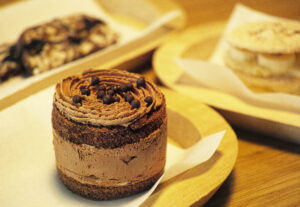There’s something magical about biting into a perfectly flaky croissant or a buttery Danish pastry—crisp outer layers giving way to soft, airy interiors. These beloved pastries are the result of laminated dough, a meticulous technique that transforms simple ingredients like flour, water, and butter into edible works of art. While the process may seem daunting, mastering it unlocks endless possibilities in the world of baking. This article demystifies the science, history, and craftsmanship behind laminated doughs, offering practical insights for novices and seasoned bakers alike.
What Is Laminated Dough, and Why Does It Matter?
At its core, laminated dough is a series of alternating layers of dough and butter. When baked, the butter melts, releasing steam that separates the dough into delicate, flaky sheets. This technique is the backbone of classics like croissants, puff pastry, and Danish pastries. The key difference between them lies in their ingredients—croissants use yeast for a lighter texture, while puff pastry relies solely on steam for rise. Danish dough often includes eggs and sugar, resulting in a richer, sweeter base.
The magic of lamination isn’t just about taste—it’s a tactile experience. Think of it as edible origami: each fold and roll traps air and fat, creating hundreds of paper-thin layers. Achieving this requires precision, patience, and an understanding of how ingredients interact under specific conditions.
How Does Science Make Laminated Doughs Flaky?
The Butter Block: Where Temperature Is Everything
Butter isn’t just an ingredient here—it’s the star. For proper lamination, it must be pliable but cold (around 60°F/15.5°C). Too warm, and it will melt into the dough instead of forming distinct layers; too cold, and it may shatter during rolling. Bakers often create a “butter block” by pounding chilled butter into a flat sheet, ensuring even distribution. “The butter’s temperature is like a ticking clock,” says pastry chef Emma Laurent. “You’re racing against the warmth of your hands and the room.”
Gluten and Fermentation: The Unsung Heroes
Gluten, the protein network formed when flour meets water, provides the dough’s structure. Overworking the dough, however, can make it tough. Resting periods between folds allow gluten to relax, ensuring the layers stay distinct. Fermentation—especially in yeast-leavened croissants—adds depth of flavor. A slow, cold proofing process lets the dough develop complex aromas while maintaining its delicate architecture.
Step-by-Step: Crafting Perfect Laminated Dough
Creating the Detrempe: The Foundation
Begin with the detrempe, the base dough. For croissants, this involves mixing flour, water, yeast, sugar, and a touch of butter. Knead just until smooth, then chill. Resting the dough hydrates the flour and relaxes the gluten, making it easier to roll later.
Folding Techniques: The Art of Turns
The iconic layers come from a series of folds called “turns”. After encasing the butter block in the detrempe, roll the dough into a rectangle and fold it into thirds—a “single turn.” Repeat this process six times, chilling the dough between each fold to keep the butter firm. Six turns create 729 layers! Visual guides or diagrams can help bakers visualize how each fold builds the pastry’s structure.
Proofing: The Final Rise
After shaping, proof the dough at a slightly warm temperature (75–80°F/24–27°C) until doubled in size. This final rise activates the yeast and sets the layers. Under-proofing results in dense pastries; over-proofing causes butter to leak. The ideal croissant will feel light and jiggle slightly when shaken.
What Are Common Mistakes When Working With Laminated Dough?
Even seasoned bakers face challenges. Uneven rolling is a frequent pitfall—thicker spots resist rising, leading to lopsided pastries. Dough tearing? It often means the butter was too cold. If layers merge during baking, the butter may have softened too much during folding. Solutions? Work in a cool kitchen, use a ruler to measure thickness, and refrigerate the dough if it becomes sticky.
Another issue is “butter blowout,” where melted butter seeps out during baking. Chef Laurent advises, “If your oven isn’t hot enough, the butter leaks before the layers set. Preheat thoroughly—ideally to 400°F/200°C—and use an oven thermometer for accuracy.”
Essential Tools for Laminated Dough Success
While professionals rely on sheeters for even rolling, home bakers can succeed with basics: a heavy rolling pin, a pastry brush for flouring, and a dough scraper to handle sticky edges. A marble slab helps keep the dough cool, but chilling baking sheets between folds works too. For precision, a laser thermometer ensures butter stays in the ideal temperature range.
Beyond Croissants: Creative Variations to Try
Once you’ve mastered the basics, experiment! Kouign-amann, a Breton pastry, adds sugar between layers for a caramelized crunch. Cronuts—the croissant-doughnut hybrid—showcase laminated dough’s versatility in fried form. For a vegan twist, substitute butter with high-fat margarine or coconut oil. Just ensure alternatives have at least 80% fat to mimic butter’s performance.
Are Laminated Pastries Worth the Calories?
Let’s be honest: these treats aren’t light. A classic croissant packs around 230 calories, mostly from butter. Yet, occasional indulgence is part of a balanced diet. For healthier versions, try whole-grain flour or reduce sugar in fillings. Gluten-free? Opting for a butter blend with xanthan gum can replicate the texture, though results may vary.
A Brief History of Layered Mastery
Laminated doughs trace back to medieval Arab cultures, where layered breads called “sfiha” inspired early puff pastry. The croissant’s origin is more contested—some credit Austrian bakers, while others attribute it to French ingenuity. Danish pastries, ironically, hail from Vienna! Today, these doughs symbolize culinary craftsmanship worldwide, from Parisian patisseries to Brooklyn’s artisanal bakeries.
Ready to Bake Your First Batch?
Laminated dough is equal parts science and intuition. Start with a simple puff pastry, and don’t fear mistakes—even uneven layers taste delicious. For visual learners, downloadable step-by-step guides or video tutorials can ease the learning curve. Remember, as chef Laurent says, “Every fold is a lesson.” Embrace the process, and soon, you’ll craft pastries that are as rewarding to make as they are to eat.
Call to Action: Ready to roll? Download our free laminated dough guide and start layering today!



